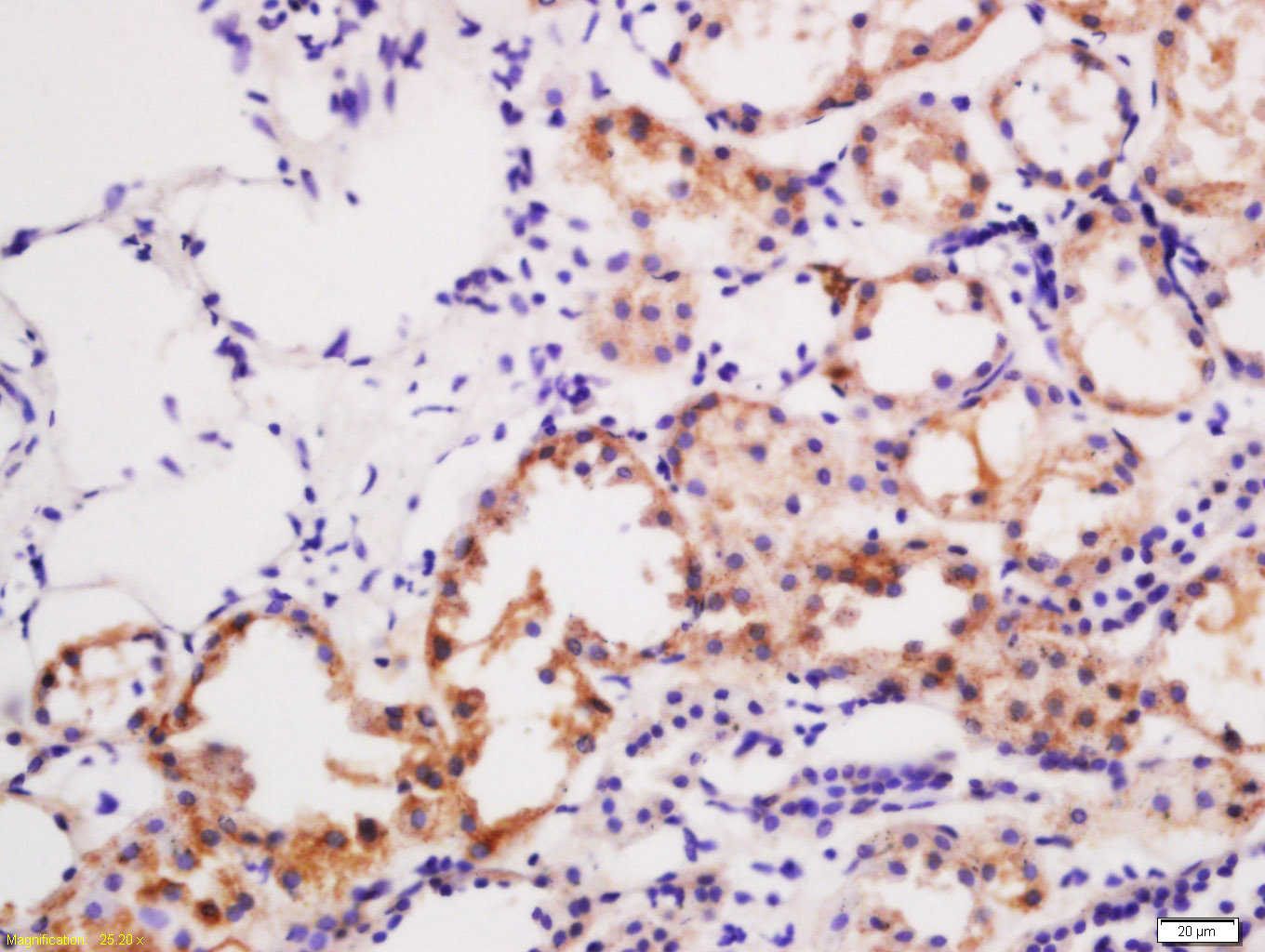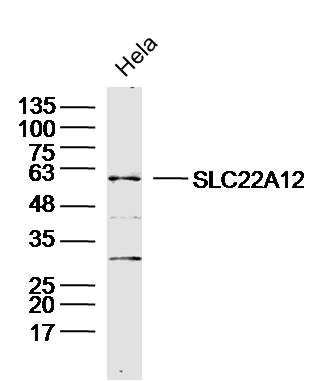SLC22A12 Rabbit pAb
SLC22A12 Rabbit pAb
- 产品详情
- 实验流程
- 背景知识
Application
| WB, IHC-P, IHC-F, IF |
|---|---|
| Primary Accession | Q96S37 |
| Reactivity | Human |
| Host | Rabbit |
| Clonality | Polyclonal |
| Calculated MW | 59630 Da |
| Physical State | Liquid |
| Immunogen | KLH conjugated synthetic peptide derived from human SLC22A12 |
| Epitope Specificity | 101-200/553 |
| Isotype | IgG |
| Purity | affinity purified by Protein A |
| Buffer | 0.01M TBS (pH7.4) with 1% BSA, 0.02% Proclin300 and 50% Glycerol. |
| SUBCELLULAR LOCATION | Cell membrane, Multi-pass membrane protein. |
| SIMILARITY | Belongs to the major facilitator (TC 2.A.1) superfamily. Organic cation transporter (TC 2.A.1.19) family. |
| SUBUNIT | Interacts with PDZK1. |
| Post-translational modifications | N-glycosylated. Contains several complex-type N-glycans. |
| DISEASE | Hypouricemia renal 1 (RHUC1) [MIM:220150]: A disorder characterized by impaired uric acid reabsorption at the apical membrane of proximal renal tubule cells, and high urinary urate excretion. Patients often appear asymptomatic, but may be subject to exercise-induced acute renal failure, chronic renal dysfunction and nephrolithiasis. Note=The disease is caused by mutations affecting the gene represented in this entry. |
| Important Note | This product as supplied is intended for research use only, not for use in human, therapeutic or diagnostic applications. |
| Background Descriptions | The protein encoded by this gene is involved in the sodium-independent transport and excretion of organic anions, some of which are potentially toxic. The encoded protein is an integral membrane protein and is found mainly in the kidney and in the placenta, where it may act to prevent potentially harmful organic anions from reaching the fetus. Alternative splicing results in multiple transcript variants. [provided by RefSeq, Apr 2015] |
| Gene ID | 116085 |
|---|---|
| Other Names | Solute carrier family 22 member 12, Organic anion transporter 4-like protein, Renal-specific transporter, RST {ECO:0000303|Ref.2}, Urate anion exchanger 1, URAT1, Urate:anion antiporter SLC22A12, SLC22A12 (HGNC:17989) |
| Target/Specificity | Detected in placenta and kidney. |
| Dilution | WB=1:500-2000,IHC-P=1:100-500,IHC-F=1:100-500,IF=1:100-500 |
| Format | 0.01M TBS(pH7.4) with 1% BSA, 0.09% (W/V) sodium azide and 50% Glyce |
| Storage | Store at -20 °C for one year. Avoid repeated freeze/thaw cycles. When reconstituted in sterile pH 7.4 0.01M PBS or diluent of antibody the antibody is stable for at least two weeks at 2-4 °C. |
| Name | SLC22A12 (HGNC:17989) |
|---|---|
| Function | Electroneutral antiporter that translocates urate across the apical membrane of proximal tubular cells in exchange for monovalent organic or inorganic anions (PubMed:12024214, PubMed:22194875, PubMed:35144162, PubMed:35462902). Involved in renal reabsorption of urate and helps maintaining blood levels of uric acid (PubMed:12024214, PubMed:22194875). Mediates urate uptake by an exchange with organic anions such as (S)-lactate and nicotinate, and inorganic anion Cl(-) (PubMed:12024214). Other inorganic anions such as Br(-), I(-) and NO3(-) may also act as counteranions that exchange for urate (PubMed:12024214). Also mediates orotate tubular uptake coupled with nicotinate efflux and to a lesser extent with lactate efflux, therefore displaying a potential role in orotate renal reabsorption (PubMed:21350910). Orotate transport is Cl(-)-dependent (PubMed:21350910). |
| Cellular Location | Apical cell membrane; Multi-pass membrane protein |
| Tissue Location | Detected in kidney (at protein level). Detected in fetal and adult kidney. Detected in epithelial cells of proximal tubules in renal cortex. |
Research Areas
For Research Use Only. Not For Use In Diagnostic Procedures.
Application Protocols
Provided below are standard protocols that you may find useful for product applications.
BACKGROUND
This product as supplied is intended for research use only, not for use in human, therapeutic or diagnostic applications.
终于等到您。ABCEPTA(百远生物)抗体产品。
点击下方“我要评价 ”按钮提交您的反馈信息,您的反馈和评价是我们最宝贵的财富之一,
我们将在1-3个工作日内处理您的反馈信息。
如有疑问,联系:0512-88856768 tech-china@abcepta.com.
¥ 1,500.00
Cat# AP94412























 癌症的基本特征包括细胞增殖、血管生成、迁移、凋亡逃避机制和细胞永生等。找到癌症发生过程中这些通路的关键标记物和对应的抗体用于检测至关重要。
癌症的基本特征包括细胞增殖、血管生成、迁移、凋亡逃避机制和细胞永生等。找到癌症发生过程中这些通路的关键标记物和对应的抗体用于检测至关重要。 为您推荐一个泛素化位点预测神器——泛素化分析工具,可以为您的蛋白的泛素化位点作出预测和评分。
为您推荐一个泛素化位点预测神器——泛素化分析工具,可以为您的蛋白的泛素化位点作出预测和评分。 细胞自噬受体图形绘图工具为你的蛋白的细胞受体结合位点作出预测和评分,识别结合到自噬通路中的蛋白是非常重要的,便于让我们理解自噬在正常生理、病理过程中的作用,如发育、细胞分化、神经退化性疾病、压力条件下、感染和癌症。
细胞自噬受体图形绘图工具为你的蛋白的细胞受体结合位点作出预测和评分,识别结合到自噬通路中的蛋白是非常重要的,便于让我们理解自噬在正常生理、病理过程中的作用,如发育、细胞分化、神经退化性疾病、压力条件下、感染和癌症。







